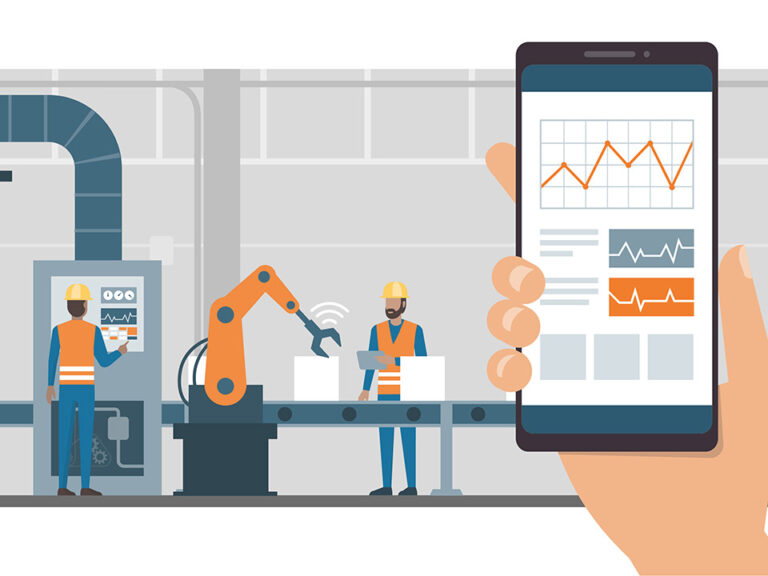Boosting Productivity: AI and Intelligent Automation Use Cases
In today’s competitive business landscape, the quest for increased productivity and efficiency has led organizations across industries, especially in the manufacturing sector, to embrace the transformative power of AI and intelligent automation. This strategic move towards automating processes and integrating artificial intelligence (AI) is not just about enhancing operational efficiency; it’s about revolutionizing the very fabric of business operations. Let’s explore the various ways that AI-powered automation is bringing businesses into a new era of productivity and efficiency.
Transforming Manufacturing with AI and Automation
Revolutionizing the Assembly Line
Automation in manufacturing has long been a staple, but the integration of AI technologies brings this to a new level. AI-driven robots and machine learning algorithms on the assembly line can optimize production processes, reducing downtime and minimizing human intervention in repetitive tasks. This not only streamlines operations but also significantly improves product quality and worker safety by reducing the likelihood of human error.
Predictive Maintenance: Minimizing Downtime
One of the most impactful applications of AI in manufacturing is predictive maintenance. By leveraging data analytics and machine learning, manufacturing companies can predict when machines are likely to fail or require maintenance. This foresight allows for proactive maintenance schedules, significantly reducing unplanned downtime and associated costs, thus ensuring continuous production flow and operational efficiency.
Streamlining Supply Chain Management
AI and automation extend their reach beyond the manufacturing floor to overhaul supply chain management. Intelligent automation systems can analyze vast amounts of data in real-time, optimizing logistics, inventory management, and demand forecasting. This not only ensures that supply always meets demand but also identifies bottlenecks and inefficiencies within the supply chain, dramatically reducing costs and improving customer satisfaction.
Beyond Manufacturing: AI in Business Processes
Automating Back-Office Operations
Back-office operations, traditionally bogged down by manual processes and human intervention, are undergoing a transformation through the use of RPA (Robotic Process Automation) and AI. From intelligent document processing that leverages natural language processing to automate data entry and management, to AI-powered analytics providing insights into business performance, automation is streamlining back-office workflows, allowing human employees to focus on more strategic tasks.
Enhancing Customer Experience
AI and automation are not just about optimizing internal processes; they’re also revolutionizing how businesses interact with their customers. AI-driven chatbots and virtual assistants are providing 24/7 customer support, handling inquiries with unprecedented efficiency and personalization. This not only enhances customer satisfaction but also leverages human customer service representatives to deal with more complex or sensitive issues.
Innovating with Generative AI
Generative AI, one of the latest advancements in artificial intelligence, is opening new avenues for creativity and innovation in product design and development. By understanding and learning from existing data, and can create new, unique product designs, content, and ideas, thereby accelerating the innovation process and reducing the time and resources required for research and development.
Conclusion
The integration of AI and intelligent automation into business operations represents a significant leap forward in the pursuit of productivity and efficiency. From revolutionizing manufacturing processes to transforming back-office operations and enhancing customer interactions, the potential of these technologies to streamline workflows and optimize operations is unparalleled.
As the landscape of industry 4.0 evolves, staying ahead of the curve requires not just adoption but also a deep understanding of how to strategically implement these technologies for maximum benefit. For businesses ready to embark on this transformative journey, Leaniar is your ideal partner. With our expertise in AI and automation solutions, we can help you unlock the full potential of these technologies, ensuring your business not only keeps pace with the digital transformation but also leads the charge.
Frequently Asked Questions
How can AI and automation improve productivity in manufacturing?
By automating repetitive tasks, optimizing production lines, and implementing predictive maintenance to reduce downtime. AI and automation can improve productivity in manufacturing by streamlining processes and increasing efficiency. For example, AI can be used to analyze data from sensors and machines in real-time, allowing for predictive maintenance to identify potential issues before they cause downtime. This can help improve overall equipment effectiveness and reduce costly unplanned downtime.
Automation can also help to optimize production lines by streamlining workflows and reducing the need for manual intervention. For example, robots can be used to perform repetitive tasks such as lifting heavy objects or assembling components, allowing workers to focus on more complex and value-added tasks. This can help improve overall production efficiency and reduce the risk of errors in the manufacturing process.
Overall, AI and automation can help manufacturers increase productivity by reducing downtime, improving efficiency, and optimizing workflows. This can lead to cost savings, higher quality products, and increased competitiveness in the market.
What are the benefits of integrating AI into supply chain management?
Enhanced demand forecasting, inventory optimization, and streamlined logistics led to cost reductions and improved efficiency. – Improved accuracy and speed in decision-making: AI algorithms can quickly analyze large amounts of data and identify patterns that humans may overlook, allowing for more accurate and timely decision-making in areas such as inventory management, demand forecasting, and supplier selection.
- Enhanced supply chain visibility: AI can provide real-time insights into the entire supply chain, from sourcing raw materials to delivering the final product to customers. This improved visibility helps organizations identify potential bottlenecks, reduce lead times, and respond quickly to disruptions.
- Predictive maintenance: AI-powered predictive analytics can help businesses identify potential equipment failures before they happen, enabling proactive maintenance and reducing downtime in the supply chain.
- Personalized customer experiences: By leveraging AI technology, companies can analyze customer data to create personalized offers and deliver customized products that meet individual preferences and demand, ultimately improving customer satisfaction and loyalty.
- Sustainability and social responsibility: AI can help organizations track and monitor their supply chain activities to ensure compliance with environmental regulations, ethical sourcing practices, and fair labor standards, leading to a more sustainable and socially responsible supply chain.
Can AI and automation impact product quality?
Yes, through precision and consistency in production processes and quality control, significantly reducing the margin for error. AI and automation can have a positive impact on product quality in several ways.
- Reduced human error: By automating tasks that are prone to human error, such as repetitive manual processes or data entry, AI and automation can help ensure greater accuracy and consistency in product production.
- Improved quality control: AI can be used to continuously monitor and analyze production processes for any deviations or abnormalities, allowing for real-time adjustments to maintain or improve product quality.
- Faster decision-making: AI algorithms can quickly process and analyze vast amounts of data to identify patterns or issues that may affect product quality, enabling faster decision-making to address these issues before they escalate.
- Predictive maintenance: AI can be used to predict when equipment may malfunction or require maintenance, reducing the risk of unexpected downtime and ensuring that products are produced under optimal conditions.
- Customization and personalization: AI can help companies better understand customer preferences and trends, allowing for more personalized product offerings that meet or exceed customer expectations.
Overall, AI and automation can help companies maintain high standards of product quality, improve efficiency, and ultimately enhance customer satisfaction.
How do AI-driven chatbots enhance customer service?
By providing immediate, 24/7 responses to customer inquiries, freeing human agents to handle more complex issues. AI-driven chatbots enhance customer service by:
- Instant responses: Chatbots can provide immediate replies to customer inquiries, reducing wait times and improving customer satisfaction.
- Personalized interactions: Chatbots can be programmed to gather information about customers and provide personalized recommendations or assistance.
- Consistent messaging: Chatbots provide the same level of service and information consistently, regardless of the time of day or number of customers.
- Handling routine tasks: Chatbots can handle routine customer service tasks such as tracking orders, providing account information, or making reservations, freeing up human agents to focus on more complex issues.
- Scalability: Chatbots can handle multiple conversations simultaneously, allowing businesses to scale their customer service operations without needing to hire more staff.
- Data collection: Chatbots can gather valuable data on customer preferences, behaviors, and trends, which can be used to improve products and services.
- Cost-effective: Chatbots can help reduce customer service costs by automating routine tasks and reducing the need for human agents to handle every interaction.
What is generative AI, and how is it being used?
Generative AI is an AI that can create new content or designs from existing data, used for innovation in product design and content creation. Works by analyzing a dataset and learning the patterns and structures within the data, allowing it to generate new content that is similar to the original input. This technology is being used in a variety of industries for tasks such as:
- Product Design: Companies are using it to come up with new product designs by analyzing existing designs and creating variations or entirely new concepts.
- Creative Content Creation: Generative AI is being used in fields such as music, art, and writing to create new and unique content. For example, it can generate music compositions, artwork, or even write stories and scripts.
- Personalized Marketing: Marketers are using generative AI to create personalized content for their audiences, such as custom advertisements or product recommendations based on individual preferences.
- Video Game Development: Game developers are using it to create realistic environments, characters, and gameplay elements to enhance the gaming experience.
- Financial Modeling: In finance, can be used to generate forecasts, investment strategies, and risk assessments based on historical data.
Overall, generative AI has the potential to revolutionize multiple industries by automating and enhancing the creative process, leading to more efficient and innovative outcomes.
How can businesses start implementing AI and automation?
By identifying areas of inefficiency or high labor costs for automation and partnering with a knowledgeable provider like Leaniar to develop and implement a tailored automation strategy. Additionally, businesses can start by investing in AI and automation technologies, providing training for employees to adapt to the new technologies, and conducting thorough testing and monitoring to ensure successful implementation. It is also important to have a clear roadmap and goals for automation implementation in order to track progress and measure success. Additionally, businesses can consider starting with smaller, low-risk automation projects before scaling up to more complex processes.






